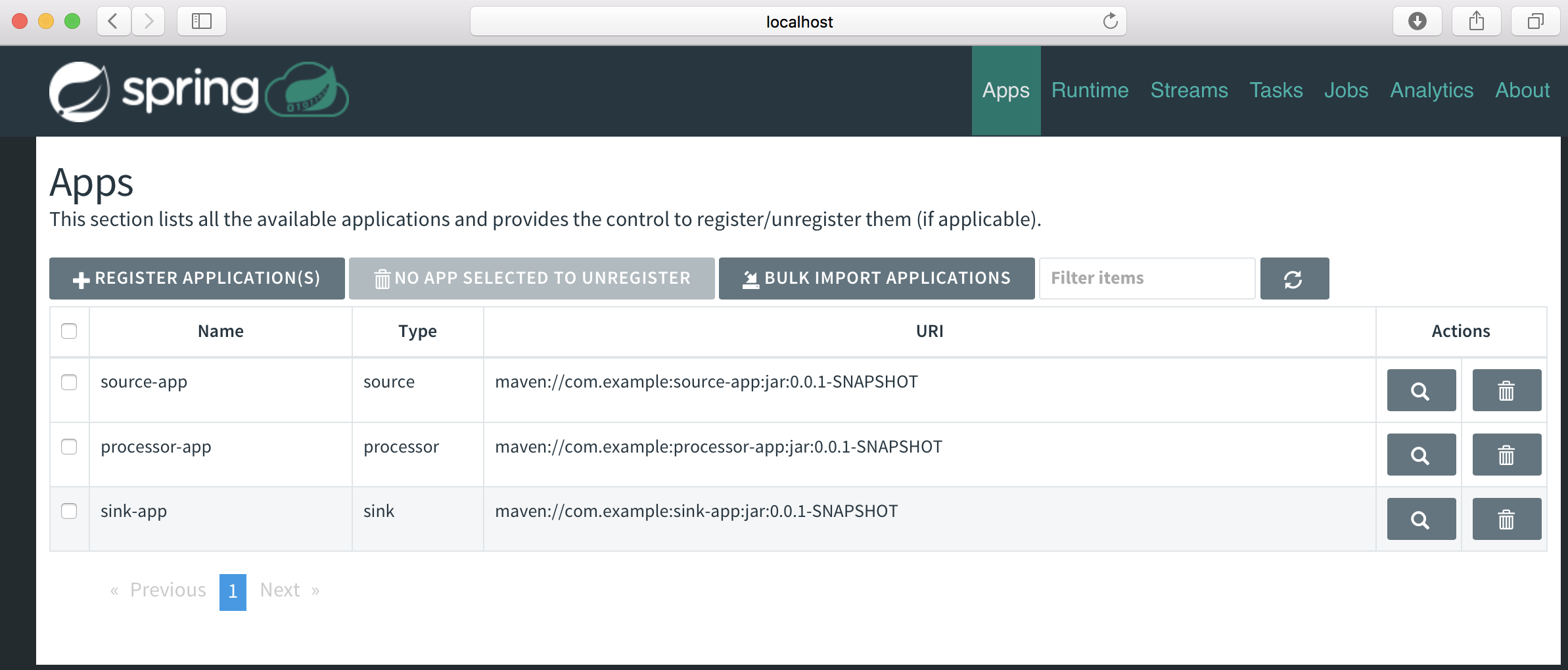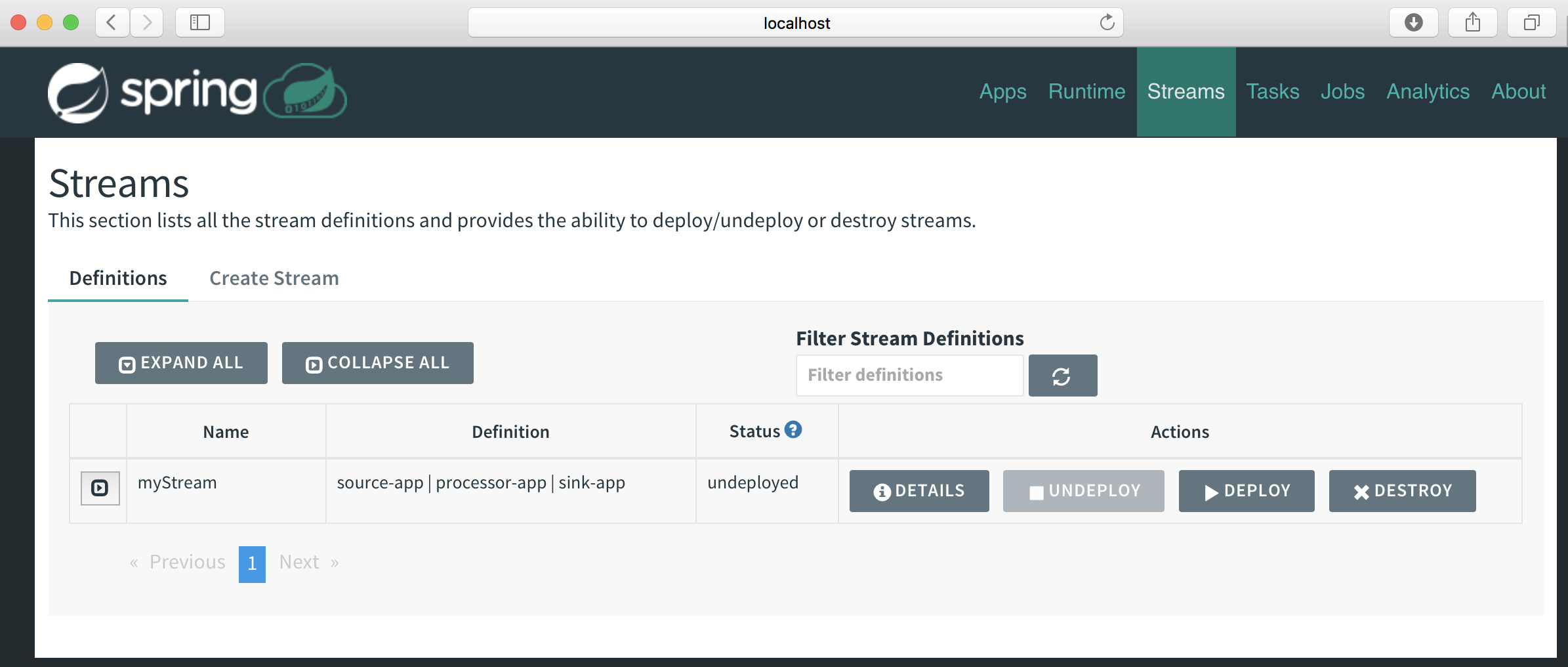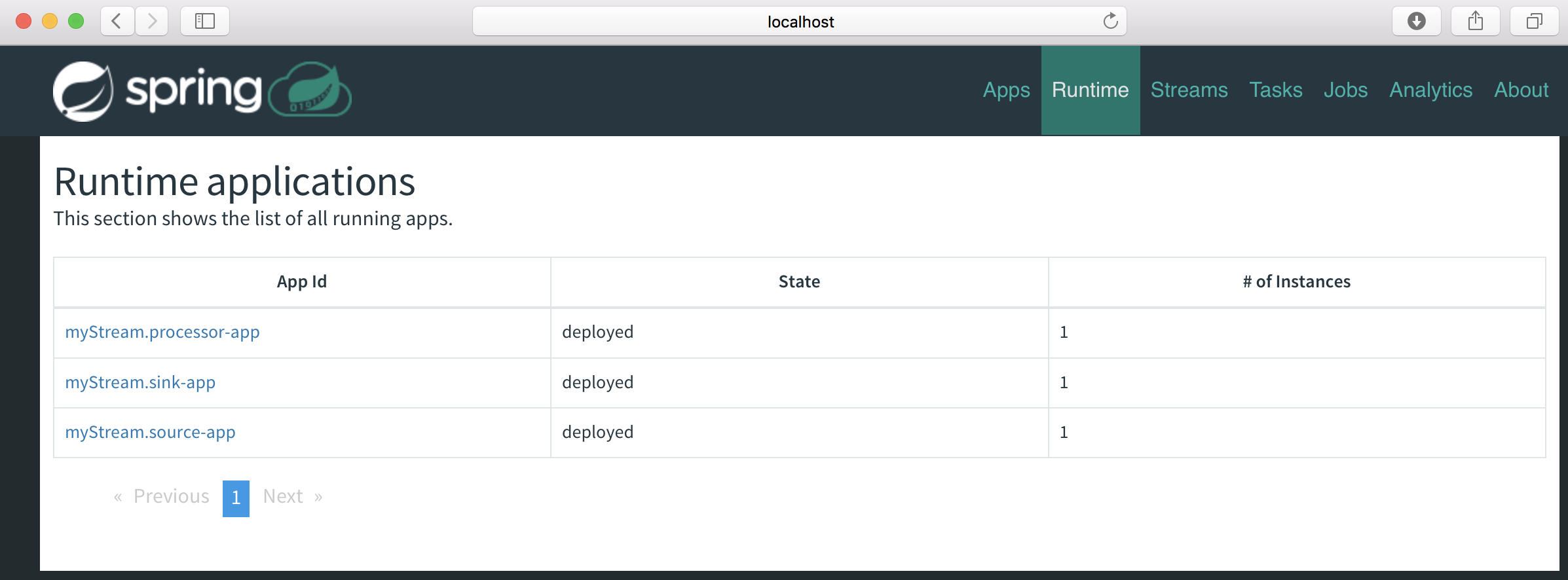In this blog post I want to show how to create a “Hello World” streaming example using Spring Cloud Data Flow which simplifies the development and deployment of applications focused on data processing use-cases. Spring Cloud Data Flow originates from Spring XD which was a standalone project to build distributed data pipelines for real-time and batch processing.
In contrast to Spring XD, in Spring Cloud Data Flow the modules are autonomous deployable Spring Boot apps, which can be run individually with java -jar.
These Spring Boot apps can use Spring Cloud Stream to quickly build a message-driven microservice, where the messaging middleware (like Apache Kafka, RabbitMQ, etc) is abstracted away.
In Spring Cloud Stream terminology streams are made up of sources, sinks and optionally processors.
Below you can see a simple source application which with the help of @InputChannelAdapter annotation sends a message every second to the output channel of the source using an auto-configured poller which can be further customized using the spring.integration.poller property.
The @EnableBinding annotation triggers the Spring Cloud Stream infrastructure.
@EnableBinding(Source.class)
@SpringBootApplication
public class SourceApp {
public static void main(String[] args) {
SpringApplication.run(SourceApp.class, args);
}
@InboundChannelAdapter(value = Source.OUTPUT)
public String source() {
return new Date().toString();
}
}
In the sink application with the help @StreamListener annotation the application receives messages from the input channel of the sink.
@EnableBinding(Sink.class)
@SpringBootApplication
@Slf4j
public class SinkApp {
public static void main(String[] args) {
SpringApplication.run(SinkApp.class, args);
}
@StreamListener(Sink.INPUT)
public void logger(String payload) {
log.info("received {}", payload);
}
}
And finally there is a simple processor application which transforms the received messages.
@SpringBootApplication
@EnableBinding(Processor.class)
@Slf4j
public class ProcessorApp {
public static void main(String[] args) {
SpringApplication.run(ProcessorApp.class, args);
}
@ServiceActivator(inputChannel = Processor.INPUT, outputChannel = Processor.OUTPUT)
public String transform(String payload) {
log.info("Processor received {}", payload);
return payload + " processed";
}
}
The parameter specified in the @EnableBinding annotation (Sink, Source, Processor) are defined in Spring Cloud Stream. They are for convenience and they use the @Input annotation to define an input channel (through which received messages enter the application) and use the @Output annotation to define an output channel (through which published messages leave the application).
The user can define its own interface specified at @EnableBinding annotation.
Running the applications without Spring Cloud Data Flow
In this example I am using RabbitMQ as a messaging middleware. Binding properties needs to be set in order for the applications to know to which exchange send or receive from the messages.
java -jar target/sink-app-0.0.1-SNAPSHOT.jar \
--spring.cloud.stream.bindings.input.destination: demo-processed
java -jar target/processor-app-0.0.1-SNAPSHOT.jar \
--spring.cloud.stream.bindings.input.destination: demo \
--spring.cloud.stream.bindings.output.destination: demo-processed
java -jar target/source-app-0.0.1-SNAPSHOT.jar \
--spring.cloud.stream.bindings.output.destination: demo
Here it is specified that messages produced by the source-app should be sent to the demo exchange, from where the processor-app should take the messages, process them and should put them on the demo-processed exchange from where finally the sink-app should take the messages and print them out.
After starting first RabbitMQ and then all the three applications you should see the that the sink-app receives the processed messages:
2017-08-24 com.example.sinkapp.SinkApp : Started SinkApp in 13.578 seconds (JVM running for 14.81)
2017-08-24 com.example.sinkapp.SinkApp : received Thu Aug 24 16:39:23 CEST 2017 processed
2017-08-24 com.example.sinkapp.SinkApp : received Thu Aug 24 16:39:24 CEST 2017 processed
...
Running the applications with Spring Cloud Data Flow
So far so good, now let’s try to run the applications with Spring Cloud Data Flow. In this example I am using the recently released 1.3.0.M1 version which comes with a nice Angular 4 based Dashboard UI.
The runtime in Spring Cloud Data Flow is very flexible. The currently supported runtimes are:
- Cloud Foundry
- Apache YARN
- Kubernetes
- Apache Mesos
- Local Server for development
To make things simple here I am going to use the Local Server version.
wget http://repo.spring.io/milestone/org/springframework/cloud/spring-cloud-dataflow-server-local/1.3.0.M1/spring-cloud-dataflow-server-local-1.3.0.M1.jar
java -jar spring-cloud-dataflow-server-local-1.3.0.M1.jar
After it is up and running you can access the built-in UI at http://localhost:9393/dashboard/#/apps
Spring Cloud Data Flow comes with a shell which can also be used interact with the server using stream DSL. In this example we are going to use this one, instead of the dashboard UI.
wget http://repo.spring.io/milestone/org/springframework/cloud/spring-cloud-dataflow-shell/1.3.0.M1/spring-cloud-dataflow-shell-1.3.0.M1.jar
java -jar spring-cloud-dataflow-shell-1.3.0.M1.jar
Before deploying the applications make sure the applications are installed in your maven repository, since we are using here Spring Boot uber-jar packaging, hosted in local maven repository. Applications packaged as a docker container is also supported. After the shell is up and running we need to register the applications.
dataflow:>app register --name source-app --type source --uri maven://com.example:source-app:jar:0.0.1-SNAPSHOT
Successfully registered application 'source:source-app'
dataflow:>app register --name processor-app --type processor --uri maven://com.example:processor-app:jar:0.0.1-SNAPSHOT
Successfully registered application 'processor:processor-app'
dataflow:>app register --name sink-app --type sink --uri maven://com.example:sink-app:jar:0.0.1-SNAPSHOT
Successfully registered application 'sink:sink-app'
dataflow:>app list
╔══════════╤═════════════╤════════╤════╗
║ source │ processor │ sink │task║
╠══════════╪═════════════╪════════╪════╣
║source-app│processor-app│sink-app│ ║
╚══════════╧═════════════╧════════╧════╝
You can also check the deployed applications in the Dashboard UI:

Another option is to register multiple apps at once. You can define them in a properties file with keys <type>.<name>. For example in the my-apps.properties.
stream.source-app=maven://com.example:source-app:jar:0.0.1-SNAPSHOT
stream.processor-app=maven://com.example:processor-app:jar:0.0.1-SNAPSHOT
stream.sink-app=maven://com.example:sink-app:jar:0.0.1-SNAPSHOT
and then you can import using:
dataflow:>app import --uri file:///<YOUR_FILE_LOCATION>/my-apps.properties
Next we need to define a stream.
dataflow:>stream create --name myStream --definition 'source-app | processor-app | sink-app'
Created new stream 'myStream'
dataflow:>stream list
╔═══════════╤═════════════════════════════════════╤══════════════════════════════════════════════════════════════════════╗
║Stream Name│ Stream Definition │ Status ║
╠═══════════╪═════════════════════════════════════╪══════════════════════════════════════════════════════════════════════╣
║myStream │source-app | processor-app | sink-app│The app or group is known to the system, but is not currently deployed║
╚═══════════╧═════════════════════════════════════╧══════════════════════════════════════════════════════════════════════╝

And then we deploy the stream
dataflow:>stream deploy --name myStream
Deployment request has been sent for stream 'myStream'
dataflow:>stream list
╔═══════════╤═════════════════════════════════════╤════════════════════════════════════════╗
║Stream Name│ Stream Definition │ Status ║
╠═══════════╪═════════════════════════════════════╪════════════════════════════════════════╣
║myStream │source-app | processor-app | sink-app│All apps have been successfully deployed║
╚═══════════╧═════════════════════════════════════╧════════════════════════════════════════╝

If the stream is deployed successfully you should check the sink-app log file in order to verify that it receives the processed messages.
...
2017-08-21 17:26:52.988 INFO 40752 --- [nio-9393-exec-2] o.s.c.d.s.c.StreamDeploymentController : Downloading resource URI [maven://com.example:sink-app:jar:0.0.1-SNAPSHOT]
2017-08-21 17:26:54.192 INFO 40752 --- [nio-9393-exec-2] o.s.c.d.s.c.StreamDeploymentController : Deploying application named [sink-app] as part of stream named [myStream] with resource URI [maven://com.example:sink-app:jar:0.0.1-SNAPSHOT]
2017-08-21 17:26:54.229 INFO 40752 --- [nio-9393-exec-2] o.s.c.d.spi.local.LocalAppDeployer : Deploying app with deploymentId myStream.sink-app instance 0.
Logs will be in /var/folders/9t/nr0ckt5571317_hf6b0hbty80000gn/T/spring-cloud-dataflow-5517844924337339292/myStream-1503329214194/myStream.sink-app
2017-08-21 17:26:54.237 INFO 40752 --- [nio-9393-exec-2] o.s.c.d.s.c.StreamDeploymentController : Downloading resource URI [maven://com.example:processor-app:jar:0.0.1-SNAPSHOT]
2017-08-21 17:26:54.950 INFO 40752 --- [nio-9393-exec-2] o.s.c.d.s.c.StreamDeploymentController : Deploying application named [processor-app] as part of stream named [myStream] with resource URI [maven://com.example:processor-app:jar:0.0.1-SNAPSHOT]
2017-08-21 17:26:54.962 INFO 40752 --- [nio-9393-exec-2] o.s.c.d.spi.local.LocalAppDeployer : Deploying app with deploymentId myStream.processor-app instance 0.
Logs will be in /var/folders/9t/nr0ckt5571317_hf6b0hbty80000gn/T/spring-cloud-dataflow-5517844924337339292/myStream-1503329214950/myStream.processor-app
2017-08-21 17:26:54.976 INFO 40752 --- [nio-9393-exec-2] o.s.c.d.s.c.StreamDeploymentController : Downloading resource URI [maven://com.example:source-app:jar:0.0.1-SNAPSHOT]
2017-08-21 17:26:55.819 INFO 40752 --- [nio-9393-exec-2] o.s.c.d.s.c.StreamDeploymentController : Deploying application named [source-app] as part of stream named [myStream] with resource URI [maven://com.example:source-app:jar:0.0.1-SNAPSHOT]
2017-08-21 17:26:55.832 INFO 40752 --- [nio-9393-exec-2] o.s.c.d.spi.local.LocalAppDeployer : Deploying app with deploymentId myStream.source-app instance 0.
Logs will be in /var/folders/9t/nr0ckt5571317_hf6b0hbty80000gn/T/spring-cloud-dataflow-5517844924337339292/myStream-1503329215820/myStream.source-app
...
You can access the source code on my github. In a following post I will look into short lived application support using Spring Cloud Task and how this integrates again with Spring Cloud Data Flow. We might even use Kubernetes as runtime instead of Local Server, so stay tuned :)
Happy coding & learning!